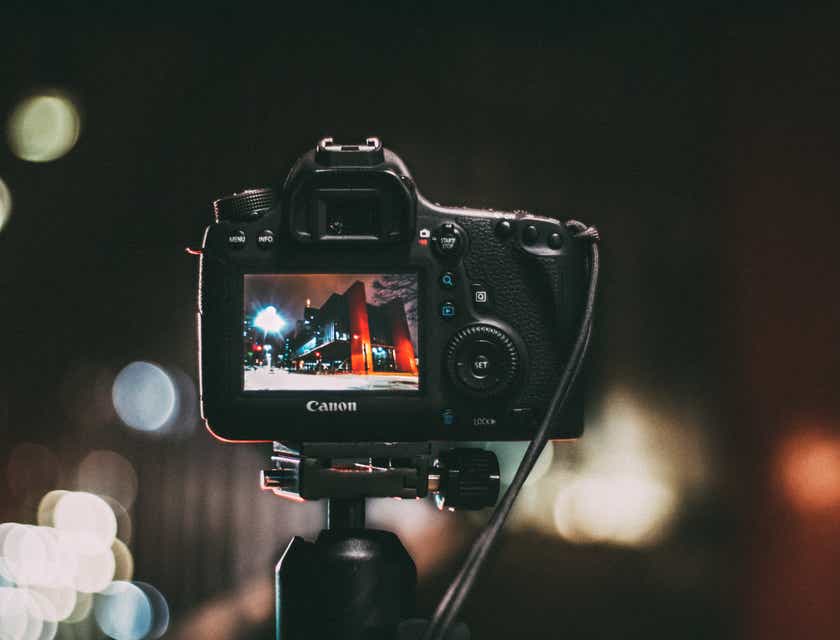
Enter your brand or company name to get started.

Photography Business Plan — Free Template
Download our photography business plan template for free.
Download NowHow to Start a Photography Business:

Follow our detailed guide on how to start a photography business, from choosing a name to registering with your state.
Decide on a subject.
Choose a subject that will always be in demand.

The key to a successful photography business is having a long-term income, meaning that you may need to focus on a stream like family photography or events, since these services will be in demand for many years to come.
Think about the required equipment involved.

Family and portrait photography may be more suitable in a studio, while event photography will require you to be mobile. The type of photography services you provide may depend on your starting capital and which equipment you can afford.
Choose a name.
Follow our guide to choosing a name.

This article on how to name a photography business provides a step-by-step guide to choosing the perfect name for your photography business.
Write a business plan.
Write an executive summary.

This section should define what your business does. It also provides an overview of the company structure.
Next, you should outline your mission statement. This should be a concise statement that encapsulates the purpose of your photography business.
Lastly, list your distinctives. This helps to differentiate you from other photography businesses.
Write a business description.

State your legal structure, location, ideas for a launch, and your sources of revenue.
Describe your marketing strategy.

List the platforms you will use to promote your business and write out your SWOT analysis.
List your competition.

Name your top competitors and note what aspects of their business may be in direct competition with yours.
Describe your financials.

Describe your startup expenses, sources of funding, financial operations, revenue projections, and a pro format profit and loss statement.
Read our photography business plan template to access a pro forma profit and loss statement spreadsheet.
Form a legal entity.
Decide on the entity you would like to register.

If you are the only person working for your company, a sole proprietorship or an LLC is probably the best option. Both allow an individual to be the owner of the business.
Trademark your business name.

Trademark your name to ensure that no other company can use it. Visit the United States Patent and Trademark Office website to do this.
Register your business.

Register your business online using your secretary of state's website.
Secure financing.
Find funders.

There are several ways in which to source funding:
Crowdfunding: You can set up crowd-sourced funding online, allowing friends, family, or interested investors to donate money towards your business. Some businesses offer to pay these initial investors interest.
Small business loan: Banks can be approached for small business loans, provided that you have a good credit score and some collateral.
Sell equity: You can sell equity in your company to get the funds you need, but this will mean splitting your ownership of the company as well as your profit.
Business credit card: Business credit cards are an option if you failed to qualify for a loan.
Purchase equipment.
Consider the essential equipment all photographers need.

Most photographers will need:
- DSLR camera (2).
- Camera lens (3).
- Speedlight flashes (2).
- Memory cards (3).
- External hard drives (2).
- Laptop (1).
- Tripods (1).
- Hardshell camera bags (1).
- Spare camera batteries (3).
- Remote triggers (2).
- Filters (2).
The total cost of these essential items is estimated to be $10,000.00.
Consider your primary location.

If you work in a studio, you may also need:
- Light heads (2).
- Light boxes (2).
- Tripods (4).
- Background light stands (2).
- Wireless remote triggers (4).
- Battery packs (2).
- Clamps (4).
- Calibrated grey card (1).
- Magic arm bracket (2).
- Light meter (1).
- Focus spotlight (1).
- Backdrop crossbar (1).
- Backdrop stands (2).
- Backdrop hooks (2).
- Reflectors (4).
- Posing stools and boxes (6).
- Props (~20).
Find a studio.
Consider a suitable location for shoots and administrative operations.

When looking for a studio, consider the following:
- Demographics.
- Accessibility.
- Proximity to service providers.
- Competition.
- Size and space requirements.
- Zoning.
- Safety and crime stats.
Apply for permits and licenses.
Check the U.S. Small Business Administration website for license and permit requirements for your location.

The U.S. Small Business Administration website will alert you to any permits and licenses you may need.
Most businesses are required to have an Employer Identification Number (EIN) and a business license.
Set up a website and social media accounts.
Research which platforms your target market frequents.

In general, the best platforms for photography businesses are:
- Facebook.
- Instagram.
- Vero Social.
- Steller Stories.
- YouPic.
- Trover.
- Pinterest.
Apply for insurance.
Find out which type of insurance you need.

Equipment Insurance will cover your equipment in the event of damage or theft.
General Liability Insurance will cover you if your equipment falls and injures somebody.
Property Insurance will cover your studio and its contents from damage or destruction.
Professional Liability/Errors & Omissions Insurance will cover you in situations where your clients are not satisfied with your work, or if you have made a mistake when taking or preparing their images.
Hire staff.
Assess your labor needs.

In the beginning, it is advisable to work independently as you build your brand and establish yourself with your clients.
As your business grows, you will need to hire staff who can help with various roles.
A receptionist will be required to welcome clients to your studio and assist with all phone, email, and social media inquiries and bookings.
Photography assistants will help the photography team with planning and setting up photo sessions, either in the studio or out at specific events and/or locations.
Photographers will perform photo shoots in studio or out at events and/or specific locations and will essentially be your representative when you have multiple bookings at the same time.
Photo editors will be tasked specifically with editing images that are taken by photographers.
Photo lab technicians will be primarily tasked with the printing of images into hardcopy, preparing canvasses, compiling photo books, and transferring digital images to mobile storage platforms.
Launch your business.
Plan your launch strategy.

Think of creative ways to advertise and attract customers. You could offer a launch special where clients receive discounts for referring their friends and family, for example.






